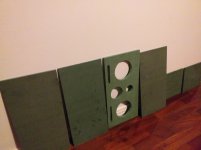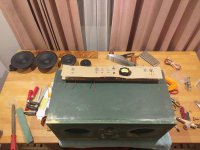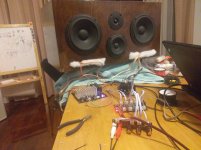Hello,
via youtube suggestions I ended up peaking into this rabbit hole, and here I am.
I think I have made it far enough to ask for input / corrections.
Im designing / building a single speaker system to use for streaming purposes. Since the speaker will have to be tolerant to placement I sought inspiration in Troel Gravesens ScanSpeak Bookshelf-3WC. The first draft of the resulting speaker however ended up having a quite low WFA. I therefore started figuring out how to scale it to a more pleasing form factor.
Objectives:
Purpose: To serve as a source for every day listening
Room: a large living room
Placement: should tolerate being placed in a bookshelf / against a wall
Size: not overly large
Cost: As a first project, on the low side while not requiring upgrades right away.
Design Summary:
Audio source: streaming (Spotify etc.)
Amplification: Two channel TPA3255 class D amp
Channels: Mono
Crossover: DSP module
Crossover point between woofers and mid range / full range driver: 300-400 Hz
Drivers: Woofer - mid and tweeter - Woofer
Enclosure volume for 6" woofers: 27 l shared (identical woofers connected in parallel to same channel)
Enclosure volume for 4" mid: 1.6 l (as in Troels speaker)
Reflex: Woofer enclosure aperiodically vented, mid driver in closed enclosure. (as in Troels speaker)
Drivers and front baffle:
Starting from Troels speaker above, I knew I wanted to have a properly tuned aperiodic enclosure to make it room friendly. But I also need some bass extension to fill a rather large room. Good dispersion of mids and highs would be a good plus, but Im not sure how to achieve that other than following Troel's design for the mid / tweeter, as he also had the same objective in a way.
I therefore took the tweeter and midrange arrangement from Troels speaker and drafted a baffle with a 6" mid-woofer on each side. Troels has a cross over point of 300 Hz between the mid range driver and the woofer, so if I want to use the 6" mid woofers for bass, I need to space them no more than 60 cm apart to be within half a wavelength of 300 Hz. By sketching up a rough draft of the baffle, it seems like I only need 18 cm mid to mid between the mid range and the woofer. 60 cm center to center for the woofers should thus not a problem and I may reduce it to provide flexibility in crossover point which can then be adjusted to end up at half wavelength if required.
But I want to start off a bit more simple with a 2way configuration and use a 4" full range driver where the 4" mid range would be in Troel's design and leave space for a tweeter for upgrading to 3way later. This also allows me to use a single amp. I intend to start off with
2x SB16PFC25-8 and 1x 10F/8414G-10.
Im thinking I wont need to pay as much attention to efficiencies between the full range driver and the woofers, since I have a DSP doing the crossover duty.
Enclosure:
Troel's enclosure is aperiodically vented and tuned to be room friendly, so how does a newb go about scaling it for two 6" woofers?
I used Speakerbuilder pro to model Troels enclosure with the 22W/8534G00. Since it is neither a reflex nor closed box design, I started by figuring out the FB for a reflex box, which seems to be about 40 Hz assuming a 22 l enclosure based on his drawings. This gives me a very similar frequency attenuation of the driver response as on his web page (both 80 Hz and 100 Hz are elevated by ca. 5db with the enclosure) for a reflex design. I furthermore checked the FB for a closed box, which is ca. 65.5 Hz.
Using these values I arrive at a volume of 27 l using 2x SB16PFC25-8 if I scale for the FB of the closed box of 65.5 Hz. I also get a very similar frequency response for a reflex enclosure as below:
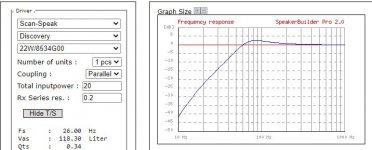
Troels - Reflex
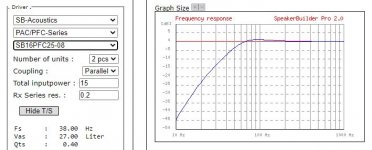
Mine - Reflex
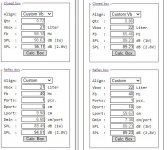
Mine to the left and Troels to the right
I guess I will have to scale the port from Troel's speaker to obtain the 40 Hz tuning and then stuff it based on how it sounds to the best of my abilities. I will then be able to adjust further with DSP.
Future upgrade potential:
Upgrade into 3way by replacing 10F/8414G-10 with 12W/8524G00 (or keep the 10F and add only a tweeter), D2608/913000 (or keep the 10F and add only a tweeter) and an extra amp. The woofers can also be upgraded with more refined 6" woofers if required (such as to 6" SBA Norex drivers).
So this would be the first stage of roughing out the design before I would start drafting the enclosure.
So what am I missing?
Any alternative (less expensive) suggestion for the full range driver (has to be able to go down to ca 300 Hz in a sealed 1.6 l enclosure)?
via youtube suggestions I ended up peaking into this rabbit hole, and here I am.
I think I have made it far enough to ask for input / corrections.
Im designing / building a single speaker system to use for streaming purposes. Since the speaker will have to be tolerant to placement I sought inspiration in Troel Gravesens ScanSpeak Bookshelf-3WC. The first draft of the resulting speaker however ended up having a quite low WFA. I therefore started figuring out how to scale it to a more pleasing form factor.
Objectives:
Purpose: To serve as a source for every day listening
Room: a large living room
Placement: should tolerate being placed in a bookshelf / against a wall
Size: not overly large
Cost: As a first project, on the low side while not requiring upgrades right away.
Design Summary:
Audio source: streaming (Spotify etc.)
Amplification: Two channel TPA3255 class D amp
Channels: Mono
Crossover: DSP module
Crossover point between woofers and mid range / full range driver: 300-400 Hz
Drivers: Woofer - mid and tweeter - Woofer
Enclosure volume for 6" woofers: 27 l shared (identical woofers connected in parallel to same channel)
Enclosure volume for 4" mid: 1.6 l (as in Troels speaker)
Reflex: Woofer enclosure aperiodically vented, mid driver in closed enclosure. (as in Troels speaker)
Drivers and front baffle:
Starting from Troels speaker above, I knew I wanted to have a properly tuned aperiodic enclosure to make it room friendly. But I also need some bass extension to fill a rather large room. Good dispersion of mids and highs would be a good plus, but Im not sure how to achieve that other than following Troel's design for the mid / tweeter, as he also had the same objective in a way.
I therefore took the tweeter and midrange arrangement from Troels speaker and drafted a baffle with a 6" mid-woofer on each side. Troels has a cross over point of 300 Hz between the mid range driver and the woofer, so if I want to use the 6" mid woofers for bass, I need to space them no more than 60 cm apart to be within half a wavelength of 300 Hz. By sketching up a rough draft of the baffle, it seems like I only need 18 cm mid to mid between the mid range and the woofer. 60 cm center to center for the woofers should thus not a problem and I may reduce it to provide flexibility in crossover point which can then be adjusted to end up at half wavelength if required.
But I want to start off a bit more simple with a 2way configuration and use a 4" full range driver where the 4" mid range would be in Troel's design and leave space for a tweeter for upgrading to 3way later. This also allows me to use a single amp. I intend to start off with
2x SB16PFC25-8 and 1x 10F/8414G-10.
Im thinking I wont need to pay as much attention to efficiencies between the full range driver and the woofers, since I have a DSP doing the crossover duty.
Enclosure:
Troel's enclosure is aperiodically vented and tuned to be room friendly, so how does a newb go about scaling it for two 6" woofers?
I used Speakerbuilder pro to model Troels enclosure with the 22W/8534G00. Since it is neither a reflex nor closed box design, I started by figuring out the FB for a reflex box, which seems to be about 40 Hz assuming a 22 l enclosure based on his drawings. This gives me a very similar frequency attenuation of the driver response as on his web page (both 80 Hz and 100 Hz are elevated by ca. 5db with the enclosure) for a reflex design. I furthermore checked the FB for a closed box, which is ca. 65.5 Hz.
Using these values I arrive at a volume of 27 l using 2x SB16PFC25-8 if I scale for the FB of the closed box of 65.5 Hz. I also get a very similar frequency response for a reflex enclosure as below:

Troels - Reflex

Mine - Reflex

Mine to the left and Troels to the right
I guess I will have to scale the port from Troel's speaker to obtain the 40 Hz tuning and then stuff it based on how it sounds to the best of my abilities. I will then be able to adjust further with DSP.
Future upgrade potential:
Upgrade into 3way by replacing 10F/8414G-10 with 12W/8524G00 (or keep the 10F and add only a tweeter), D2608/913000 (or keep the 10F and add only a tweeter) and an extra amp. The woofers can also be upgraded with more refined 6" woofers if required (such as to 6" SBA Norex drivers).
So this would be the first stage of roughing out the design before I would start drafting the enclosure.
So what am I missing?
Any alternative (less expensive) suggestion for the full range driver (has to be able to go down to ca 300 Hz in a sealed 1.6 l enclosure)?
Last edited:
Define 'good'. Troels didn't have anything to say on the matter that I could see in the attached article.Good dispersion of mids and highs would be a good plus, but Im not sure how to achieve that other than following Troel's design for the mid / tweeter, as he also had the same objective in a way.
I had another look, these would be the sections I interpreted in this way.
Perhaps he mainly achieved this through the use of LR4 between mid-tweeter (simple enough with a dsp, I understand) and less with driver selection and spacing.
I also wanted this speaker to be easy on cabinet construction, hence a flat front panel and a 4th order crossover between mid and tweeter, allowing proper phase integration - and not least reduced crossover lobing in upper-mid/lower treble, as this speaker is likely to be used for "music in a room" - and not "head-in-vice" pin-point-imaging kind of situation. Most of us listen to music while doing something else.
....
The crossover features LR2 filter for bass-mid and LR4 for mid-tweeter sections. As these speakers are designed to be placed horizontally, crossover lobing is a concern and here the LR4, due to reduced overlap does better.
Perhaps he mainly achieved this through the use of LR4 between mid-tweeter (simple enough with a dsp, I understand) and less with driver selection and spacing.
If you have chosen this method for that reason then the task will be more difficult, as you have decided to skip the measurement and simulation stage.(simple enough with a dsp, I understand)
The things Troels mentions have more than one point of view. It would help to understand the compromises yourself.
If you have chosen this method for that reason then the task will be more difficult, as you have decided to skip the measurement and simulation stage.
The things Troels mentions have more than one point of view. It would help to understand the compromises yourself.
Yes, Im fully aware that Im trying to reverse engineer something I dont really understand, hence this thread.
Im not saying I wont simulate or do measurements, I just first wanted to see if the general concept was flawed before taking the next step. If I have scaled the enclosure sufficiently well with Speakerbuilder Pro and arrived at a woofer selection, which based on the frequency response might result in good bass, I could then start going into more detail.
I drafted a quick front view.
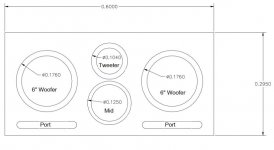
In the intial 2way configuration, the tweeter would not be installed, and the mid would be a full range. As before the woofers would be in parallel and the distance between them (0.36 m center to center) is less than 1/2 wavelength of the crossover point (0.45m at 450 Hz) to the mid-driver.

In the intial 2way configuration, the tweeter would not be installed, and the mid would be a full range. As before the woofers would be in parallel and the distance between them (0.36 m center to center) is less than 1/2 wavelength of the crossover point (0.45m at 450 Hz) to the mid-driver.
Last edited:
The concept of using a higher order LR filter to reduce the spread of the lobing is a compromise situation. However, I think you should not worry and go ahead with it anyway.. it is an advanced topic. Troels makes no attempt to address it and you should take what you read there on the topic with a grain of salt.I just first wanted to see if the general concept was flawed before taking the next step.
Thank you very much Allen.
I have made a bit of progress since I last posted. The 10F/8414G-10 is quite expensive. I can actually get get an extra class D amp plus two drivers for less money.
I decided to go with:
- 2x SB16PFCR25-8 in parallel for bass
- 1x SB12PFCR25-04 for midrange
- 1x SB19ST-C000-4 as a tweeter.
I selected a 3/4" tweeter based on the requirement for wide dispersion. The tweeter chosen seems to be quite well reviewed, given the budget.
For the midrange I made the following comparison based on the anticipated crossover points:

Spending money on a norex midrange driver, does not seem to pay off based on my limited knowledge.
I would be quite open to suggestions.
I have made a bit of progress since I last posted. The 10F/8414G-10 is quite expensive. I can actually get get an extra class D amp plus two drivers for less money.
I decided to go with:
- 2x SB16PFCR25-8 in parallel for bass
- 1x SB12PFCR25-04 for midrange
- 1x SB19ST-C000-4 as a tweeter.
I selected a 3/4" tweeter based on the requirement for wide dispersion. The tweeter chosen seems to be quite well reviewed, given the budget.
For the midrange I made the following comparison based on the anticipated crossover points:

Spending money on a norex midrange driver, does not seem to pay off based on my limited knowledge.
I would be quite open to suggestions.
Last edited:
- Home
- Loudspeakers
- Multi-Way
- Active two/three way single speaker (mono) system

